Analyzing the Effects of Terrorism Fear in Australian Society
VerifiedAdded on 2020/03/13
|8
|2674
|382
Essay
AI Summary
This essay delves into the multifaceted effects of terrorism fear on Australian society. It examines how the 'war on terror' and the 9/11 attacks have shaped public perception and influenced counter-terrorism measures. The essay explores the impact of increased security, surveillance, and legislative amendments on everyday life, highlighting the role of media and political rhetoric in constructing a climate of fear. It analyzes the shift from situational emotional responses to a perpetual state of alertness, where ordinary objects and situations are subliminally linked to the threat of terrorism. Furthermore, the essay discusses the government's response through legislative changes and the implications of these measures on civil liberties and social harmony. The essay also explores the public's perception of risk versus the actual threat profile and the potential for irrational fears, ultimately arguing that the fear of terrorism has tangible consequences, including increased discrimination, social disharmony, and the vilification of certain groups. The study concludes that the fear of terrorism is not merely the fear of impending doom, but a complex interplay of political, social, and psychological factors that affect the daily lives of Australians.
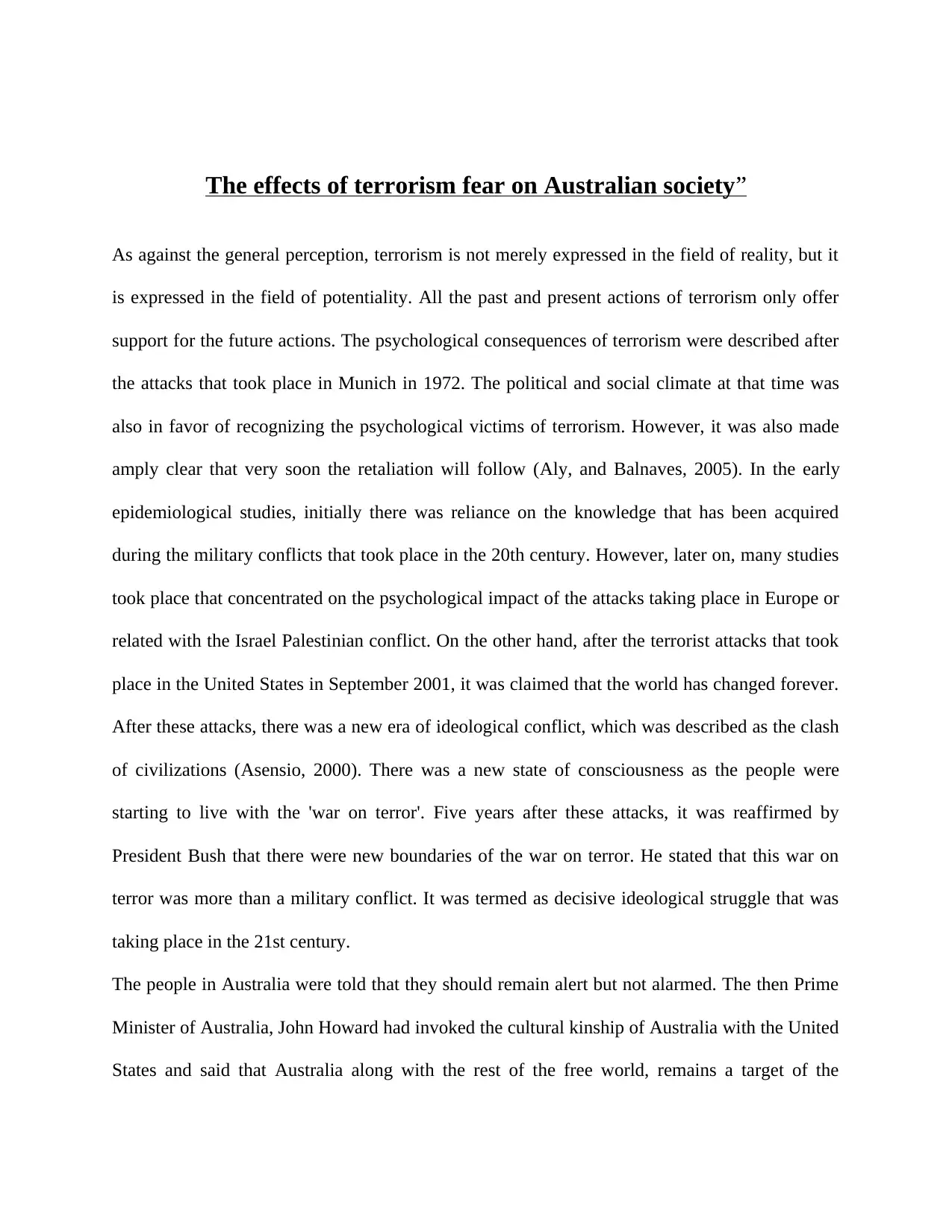
The effects of terrorism fear on Australian society”
As against the general perception, terrorism is not merely expressed in the field of reality, but it
is expressed in the field of potentiality. All the past and present actions of terrorism only offer
support for the future actions. The psychological consequences of terrorism were described after
the attacks that took place in Munich in 1972. The political and social climate at that time was
also in favor of recognizing the psychological victims of terrorism. However, it was also made
amply clear that very soon the retaliation will follow (Aly, and Balnaves, 2005). In the early
epidemiological studies, initially there was reliance on the knowledge that has been acquired
during the military conflicts that took place in the 20th century. However, later on, many studies
took place that concentrated on the psychological impact of the attacks taking place in Europe or
related with the Israel Palestinian conflict. On the other hand, after the terrorist attacks that took
place in the United States in September 2001, it was claimed that the world has changed forever.
After these attacks, there was a new era of ideological conflict, which was described as the clash
of civilizations (Asensio, 2000). There was a new state of consciousness as the people were
starting to live with the 'war on terror'. Five years after these attacks, it was reaffirmed by
President Bush that there were new boundaries of the war on terror. He stated that this war on
terror was more than a military conflict. It was termed as decisive ideological struggle that was
taking place in the 21st century.
The people in Australia were told that they should remain alert but not alarmed. The then Prime
Minister of Australia, John Howard had invoked the cultural kinship of Australia with the United
States and said that Australia along with the rest of the free world, remains a target of the
As against the general perception, terrorism is not merely expressed in the field of reality, but it
is expressed in the field of potentiality. All the past and present actions of terrorism only offer
support for the future actions. The psychological consequences of terrorism were described after
the attacks that took place in Munich in 1972. The political and social climate at that time was
also in favor of recognizing the psychological victims of terrorism. However, it was also made
amply clear that very soon the retaliation will follow (Aly, and Balnaves, 2005). In the early
epidemiological studies, initially there was reliance on the knowledge that has been acquired
during the military conflicts that took place in the 20th century. However, later on, many studies
took place that concentrated on the psychological impact of the attacks taking place in Europe or
related with the Israel Palestinian conflict. On the other hand, after the terrorist attacks that took
place in the United States in September 2001, it was claimed that the world has changed forever.
After these attacks, there was a new era of ideological conflict, which was described as the clash
of civilizations (Asensio, 2000). There was a new state of consciousness as the people were
starting to live with the 'war on terror'. Five years after these attacks, it was reaffirmed by
President Bush that there were new boundaries of the war on terror. He stated that this war on
terror was more than a military conflict. It was termed as decisive ideological struggle that was
taking place in the 21st century.
The people in Australia were told that they should remain alert but not alarmed. The then Prime
Minister of Australia, John Howard had invoked the cultural kinship of Australia with the United
States and said that Australia along with the rest of the free world, remains a target of the
Paraphrase This Document
Need a fresh take? Get an instant paraphrase of this document with our AI Paraphraser
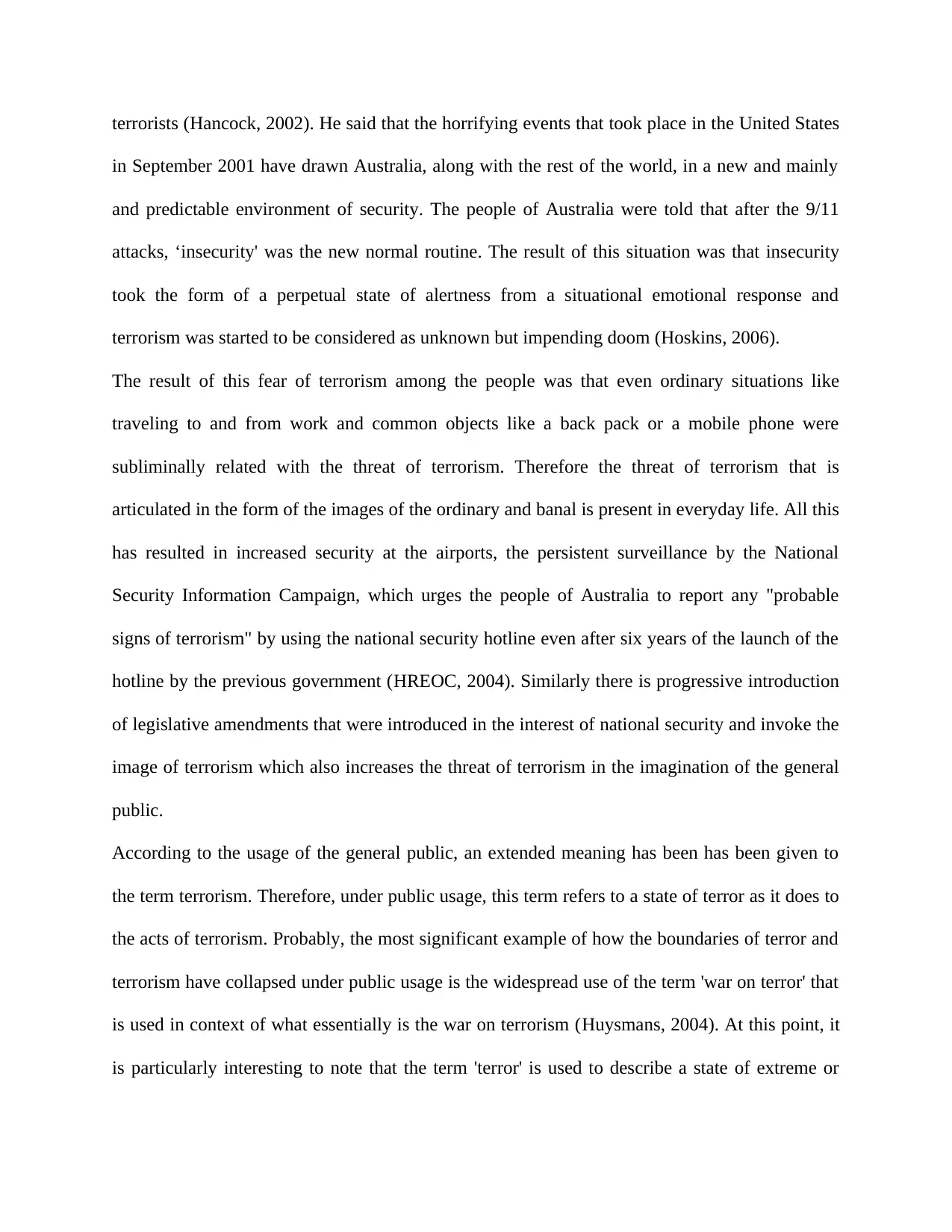
terrorists (Hancock, 2002). He said that the horrifying events that took place in the United States
in September 2001 have drawn Australia, along with the rest of the world, in a new and mainly
and predictable environment of security. The people of Australia were told that after the 9/11
attacks, ‘insecurity' was the new normal routine. The result of this situation was that insecurity
took the form of a perpetual state of alertness from a situational emotional response and
terrorism was started to be considered as unknown but impending doom (Hoskins, 2006).
The result of this fear of terrorism among the people was that even ordinary situations like
traveling to and from work and common objects like a back pack or a mobile phone were
subliminally related with the threat of terrorism. Therefore the threat of terrorism that is
articulated in the form of the images of the ordinary and banal is present in everyday life. All this
has resulted in increased security at the airports, the persistent surveillance by the National
Security Information Campaign, which urges the people of Australia to report any "probable
signs of terrorism" by using the national security hotline even after six years of the launch of the
hotline by the previous government (HREOC, 2004). Similarly there is progressive introduction
of legislative amendments that were introduced in the interest of national security and invoke the
image of terrorism which also increases the threat of terrorism in the imagination of the general
public.
According to the usage of the general public, an extended meaning has been has been given to
the term terrorism. Therefore, under public usage, this term refers to a state of terror as it does to
the acts of terrorism. Probably, the most significant example of how the boundaries of terror and
terrorism have collapsed under public usage is the widespread use of the term 'war on terror' that
is used in context of what essentially is the war on terrorism (Huysmans, 2004). At this point, it
is particularly interesting to note that the term 'terror' is used to describe a state of extreme or
in September 2001 have drawn Australia, along with the rest of the world, in a new and mainly
and predictable environment of security. The people of Australia were told that after the 9/11
attacks, ‘insecurity' was the new normal routine. The result of this situation was that insecurity
took the form of a perpetual state of alertness from a situational emotional response and
terrorism was started to be considered as unknown but impending doom (Hoskins, 2006).
The result of this fear of terrorism among the people was that even ordinary situations like
traveling to and from work and common objects like a back pack or a mobile phone were
subliminally related with the threat of terrorism. Therefore the threat of terrorism that is
articulated in the form of the images of the ordinary and banal is present in everyday life. All this
has resulted in increased security at the airports, the persistent surveillance by the National
Security Information Campaign, which urges the people of Australia to report any "probable
signs of terrorism" by using the national security hotline even after six years of the launch of the
hotline by the previous government (HREOC, 2004). Similarly there is progressive introduction
of legislative amendments that were introduced in the interest of national security and invoke the
image of terrorism which also increases the threat of terrorism in the imagination of the general
public.
According to the usage of the general public, an extended meaning has been has been given to
the term terrorism. Therefore, under public usage, this term refers to a state of terror as it does to
the acts of terrorism. Probably, the most significant example of how the boundaries of terror and
terrorism have collapsed under public usage is the widespread use of the term 'war on terror' that
is used in context of what essentially is the war on terrorism (Huysmans, 2004). At this point, it
is particularly interesting to note that the term 'terror' is used to describe a state of extreme or
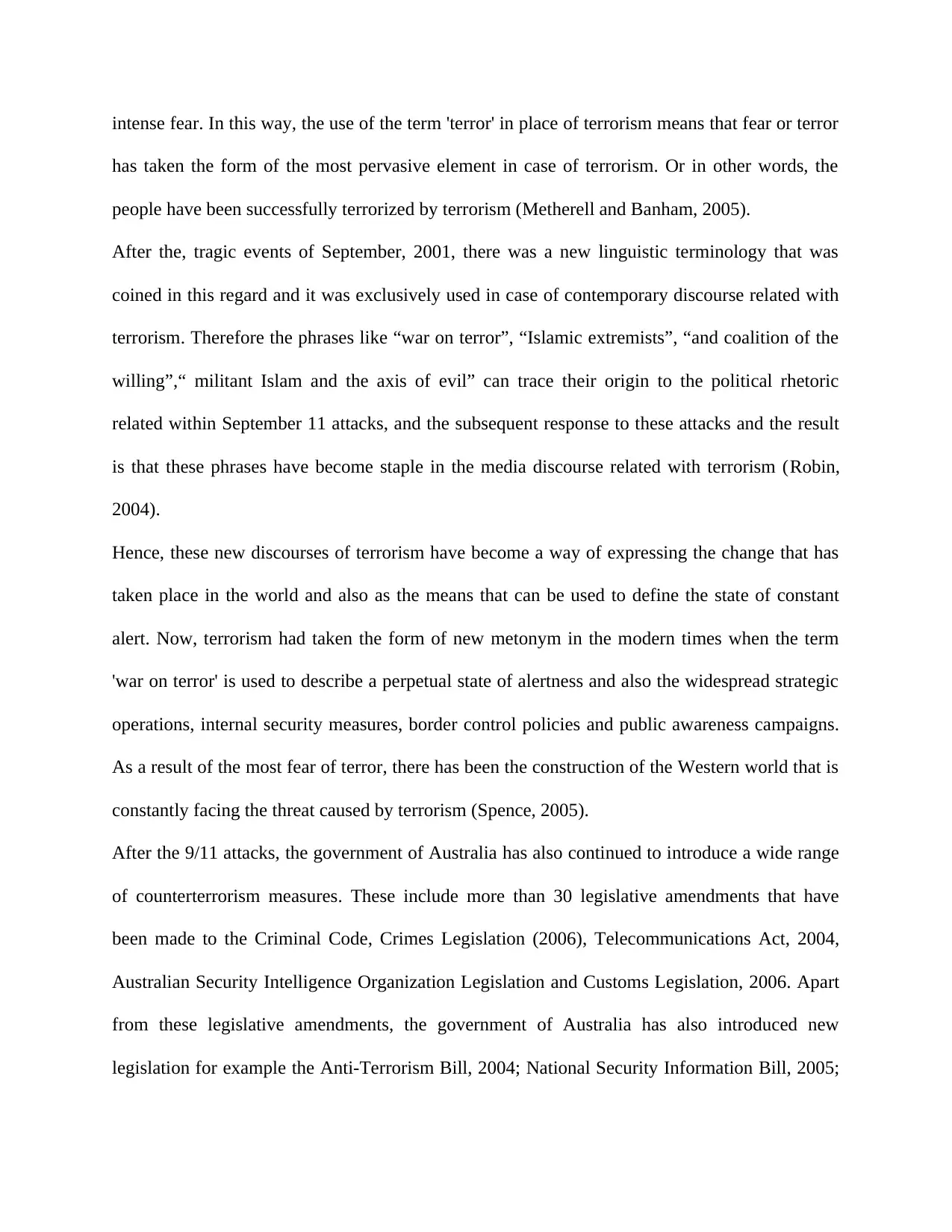
intense fear. In this way, the use of the term 'terror' in place of terrorism means that fear or terror
has taken the form of the most pervasive element in case of terrorism. Or in other words, the
people have been successfully terrorized by terrorism (Metherell and Banham, 2005).
After the, tragic events of September, 2001, there was a new linguistic terminology that was
coined in this regard and it was exclusively used in case of contemporary discourse related with
terrorism. Therefore the phrases like “war on terror”, “Islamic extremists”, “and coalition of the
willing”,“ militant Islam and the axis of evil” can trace their origin to the political rhetoric
related within September 11 attacks, and the subsequent response to these attacks and the result
is that these phrases have become staple in the media discourse related with terrorism (Robin,
2004).
Hence, these new discourses of terrorism have become a way of expressing the change that has
taken place in the world and also as the means that can be used to define the state of constant
alert. Now, terrorism had taken the form of new metonym in the modern times when the term
'war on terror' is used to describe a perpetual state of alertness and also the widespread strategic
operations, internal security measures, border control policies and public awareness campaigns.
As a result of the most fear of terror, there has been the construction of the Western world that is
constantly facing the threat caused by terrorism (Spence, 2005).
After the 9/11 attacks, the government of Australia has also continued to introduce a wide range
of counterterrorism measures. These include more than 30 legislative amendments that have
been made to the Criminal Code, Crimes Legislation (2006), Telecommunications Act, 2004,
Australian Security Intelligence Organization Legislation and Customs Legislation, 2006. Apart
from these legislative amendments, the government of Australia has also introduced new
legislation for example the Anti-Terrorism Bill, 2004; National Security Information Bill, 2005;
has taken the form of the most pervasive element in case of terrorism. Or in other words, the
people have been successfully terrorized by terrorism (Metherell and Banham, 2005).
After the, tragic events of September, 2001, there was a new linguistic terminology that was
coined in this regard and it was exclusively used in case of contemporary discourse related with
terrorism. Therefore the phrases like “war on terror”, “Islamic extremists”, “and coalition of the
willing”,“ militant Islam and the axis of evil” can trace their origin to the political rhetoric
related within September 11 attacks, and the subsequent response to these attacks and the result
is that these phrases have become staple in the media discourse related with terrorism (Robin,
2004).
Hence, these new discourses of terrorism have become a way of expressing the change that has
taken place in the world and also as the means that can be used to define the state of constant
alert. Now, terrorism had taken the form of new metonym in the modern times when the term
'war on terror' is used to describe a perpetual state of alertness and also the widespread strategic
operations, internal security measures, border control policies and public awareness campaigns.
As a result of the most fear of terror, there has been the construction of the Western world that is
constantly facing the threat caused by terrorism (Spence, 2005).
After the 9/11 attacks, the government of Australia has also continued to introduce a wide range
of counterterrorism measures. These include more than 30 legislative amendments that have
been made to the Criminal Code, Crimes Legislation (2006), Telecommunications Act, 2004,
Australian Security Intelligence Organization Legislation and Customs Legislation, 2006. Apart
from these legislative amendments, the government of Australia has also introduced new
legislation for example the Anti-Terrorism Bill, 2004; National Security Information Bill, 2005;
⊘ This is a preview!⊘
Do you want full access?
Subscribe today to unlock all pages.

Trusted by 1+ million students worldwide
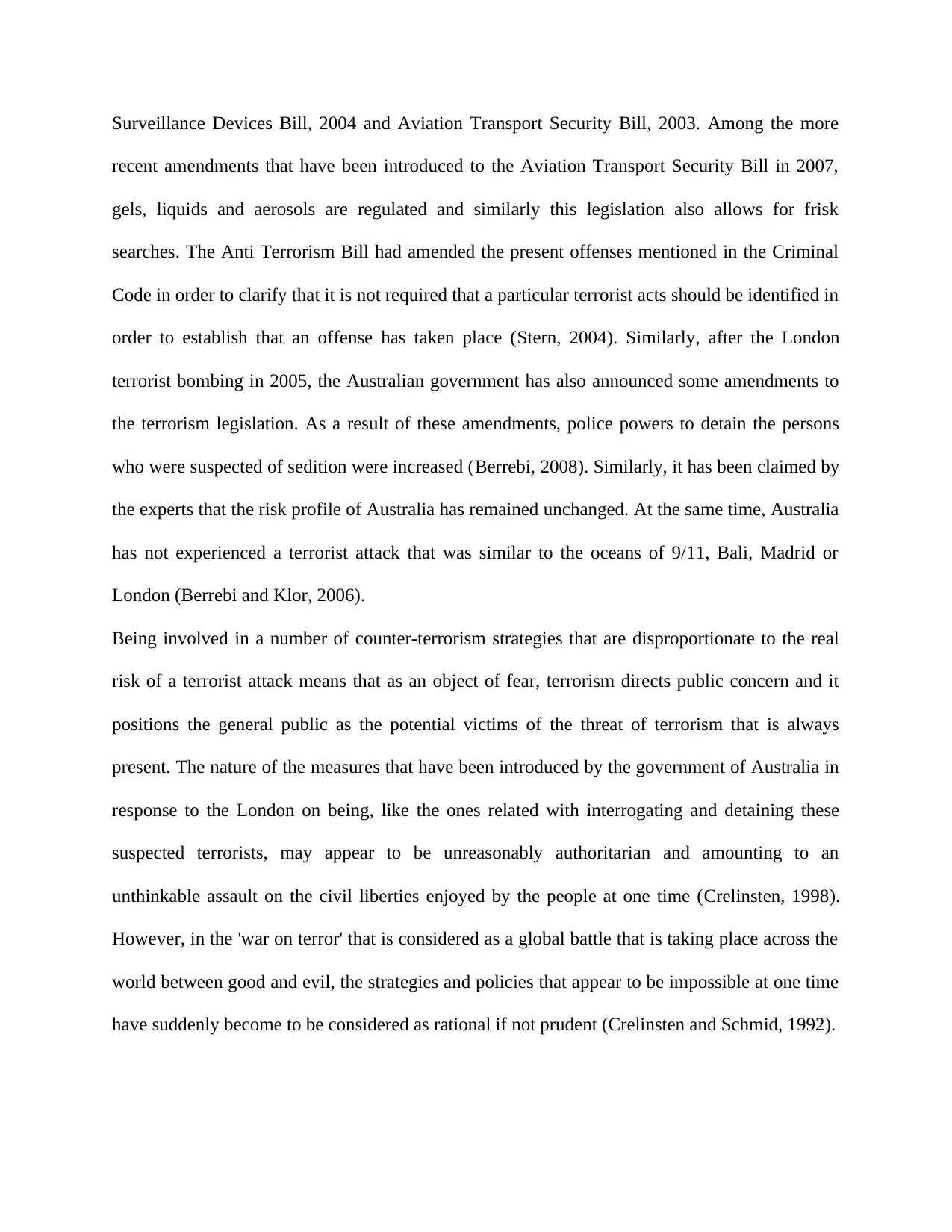
Surveillance Devices Bill, 2004 and Aviation Transport Security Bill, 2003. Among the more
recent amendments that have been introduced to the Aviation Transport Security Bill in 2007,
gels, liquids and aerosols are regulated and similarly this legislation also allows for frisk
searches. The Anti Terrorism Bill had amended the present offenses mentioned in the Criminal
Code in order to clarify that it is not required that a particular terrorist acts should be identified in
order to establish that an offense has taken place (Stern, 2004). Similarly, after the London
terrorist bombing in 2005, the Australian government has also announced some amendments to
the terrorism legislation. As a result of these amendments, police powers to detain the persons
who were suspected of sedition were increased (Berrebi, 2008). Similarly, it has been claimed by
the experts that the risk profile of Australia has remained unchanged. At the same time, Australia
has not experienced a terrorist attack that was similar to the oceans of 9/11, Bali, Madrid or
London (Berrebi and Klor, 2006).
Being involved in a number of counter-terrorism strategies that are disproportionate to the real
risk of a terrorist attack means that as an object of fear, terrorism directs public concern and it
positions the general public as the potential victims of the threat of terrorism that is always
present. The nature of the measures that have been introduced by the government of Australia in
response to the London on being, like the ones related with interrogating and detaining these
suspected terrorists, may appear to be unreasonably authoritarian and amounting to an
unthinkable assault on the civil liberties enjoyed by the people at one time (Crelinsten, 1998).
However, in the 'war on terror' that is considered as a global battle that is taking place across the
world between good and evil, the strategies and policies that appear to be impossible at one time
have suddenly become to be considered as rational if not prudent (Crelinsten and Schmid, 1992).
recent amendments that have been introduced to the Aviation Transport Security Bill in 2007,
gels, liquids and aerosols are regulated and similarly this legislation also allows for frisk
searches. The Anti Terrorism Bill had amended the present offenses mentioned in the Criminal
Code in order to clarify that it is not required that a particular terrorist acts should be identified in
order to establish that an offense has taken place (Stern, 2004). Similarly, after the London
terrorist bombing in 2005, the Australian government has also announced some amendments to
the terrorism legislation. As a result of these amendments, police powers to detain the persons
who were suspected of sedition were increased (Berrebi, 2008). Similarly, it has been claimed by
the experts that the risk profile of Australia has remained unchanged. At the same time, Australia
has not experienced a terrorist attack that was similar to the oceans of 9/11, Bali, Madrid or
London (Berrebi and Klor, 2006).
Being involved in a number of counter-terrorism strategies that are disproportionate to the real
risk of a terrorist attack means that as an object of fear, terrorism directs public concern and it
positions the general public as the potential victims of the threat of terrorism that is always
present. The nature of the measures that have been introduced by the government of Australia in
response to the London on being, like the ones related with interrogating and detaining these
suspected terrorists, may appear to be unreasonably authoritarian and amounting to an
unthinkable assault on the civil liberties enjoyed by the people at one time (Crelinsten, 1998).
However, in the 'war on terror' that is considered as a global battle that is taking place across the
world between good and evil, the strategies and policies that appear to be impossible at one time
have suddenly become to be considered as rational if not prudent (Crelinsten and Schmid, 1992).
Paraphrase This Document
Need a fresh take? Get an instant paraphrase of this document with our AI Paraphraser
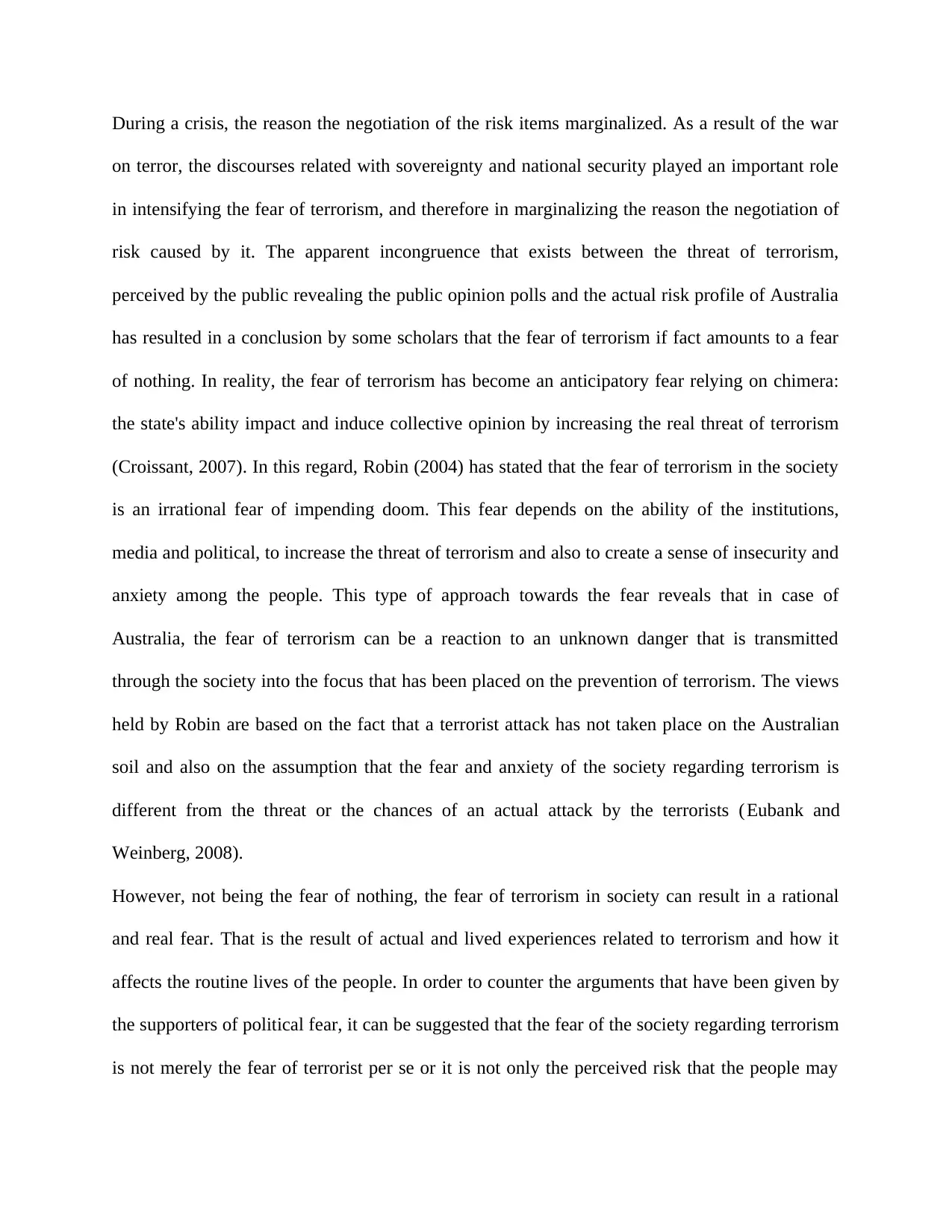
During a crisis, the reason the negotiation of the risk items marginalized. As a result of the war
on terror, the discourses related with sovereignty and national security played an important role
in intensifying the fear of terrorism, and therefore in marginalizing the reason the negotiation of
risk caused by it. The apparent incongruence that exists between the threat of terrorism,
perceived by the public revealing the public opinion polls and the actual risk profile of Australia
has resulted in a conclusion by some scholars that the fear of terrorism if fact amounts to a fear
of nothing. In reality, the fear of terrorism has become an anticipatory fear relying on chimera:
the state's ability impact and induce collective opinion by increasing the real threat of terrorism
(Croissant, 2007). In this regard, Robin (2004) has stated that the fear of terrorism in the society
is an irrational fear of impending doom. This fear depends on the ability of the institutions,
media and political, to increase the threat of terrorism and also to create a sense of insecurity and
anxiety among the people. This type of approach towards the fear reveals that in case of
Australia, the fear of terrorism can be a reaction to an unknown danger that is transmitted
through the society into the focus that has been placed on the prevention of terrorism. The views
held by Robin are based on the fact that a terrorist attack has not taken place on the Australian
soil and also on the assumption that the fear and anxiety of the society regarding terrorism is
different from the threat or the chances of an actual attack by the terrorists (Eubank and
Weinberg, 2008).
However, not being the fear of nothing, the fear of terrorism in society can result in a rational
and real fear. That is the result of actual and lived experiences related to terrorism and how it
affects the routine lives of the people. In order to counter the arguments that have been given by
the supporters of political fear, it can be suggested that the fear of the society regarding terrorism
is not merely the fear of terrorist per se or it is not only the perceived risk that the people may
on terror, the discourses related with sovereignty and national security played an important role
in intensifying the fear of terrorism, and therefore in marginalizing the reason the negotiation of
risk caused by it. The apparent incongruence that exists between the threat of terrorism,
perceived by the public revealing the public opinion polls and the actual risk profile of Australia
has resulted in a conclusion by some scholars that the fear of terrorism if fact amounts to a fear
of nothing. In reality, the fear of terrorism has become an anticipatory fear relying on chimera:
the state's ability impact and induce collective opinion by increasing the real threat of terrorism
(Croissant, 2007). In this regard, Robin (2004) has stated that the fear of terrorism in the society
is an irrational fear of impending doom. This fear depends on the ability of the institutions,
media and political, to increase the threat of terrorism and also to create a sense of insecurity and
anxiety among the people. This type of approach towards the fear reveals that in case of
Australia, the fear of terrorism can be a reaction to an unknown danger that is transmitted
through the society into the focus that has been placed on the prevention of terrorism. The views
held by Robin are based on the fact that a terrorist attack has not taken place on the Australian
soil and also on the assumption that the fear and anxiety of the society regarding terrorism is
different from the threat or the chances of an actual attack by the terrorists (Eubank and
Weinberg, 2008).
However, not being the fear of nothing, the fear of terrorism in society can result in a rational
and real fear. That is the result of actual and lived experiences related to terrorism and how it
affects the routine lives of the people. In order to counter the arguments that have been given by
the supporters of political fear, it can be suggested that the fear of the society regarding terrorism
is not merely the fear of terrorist per se or it is not only the perceived risk that the people may
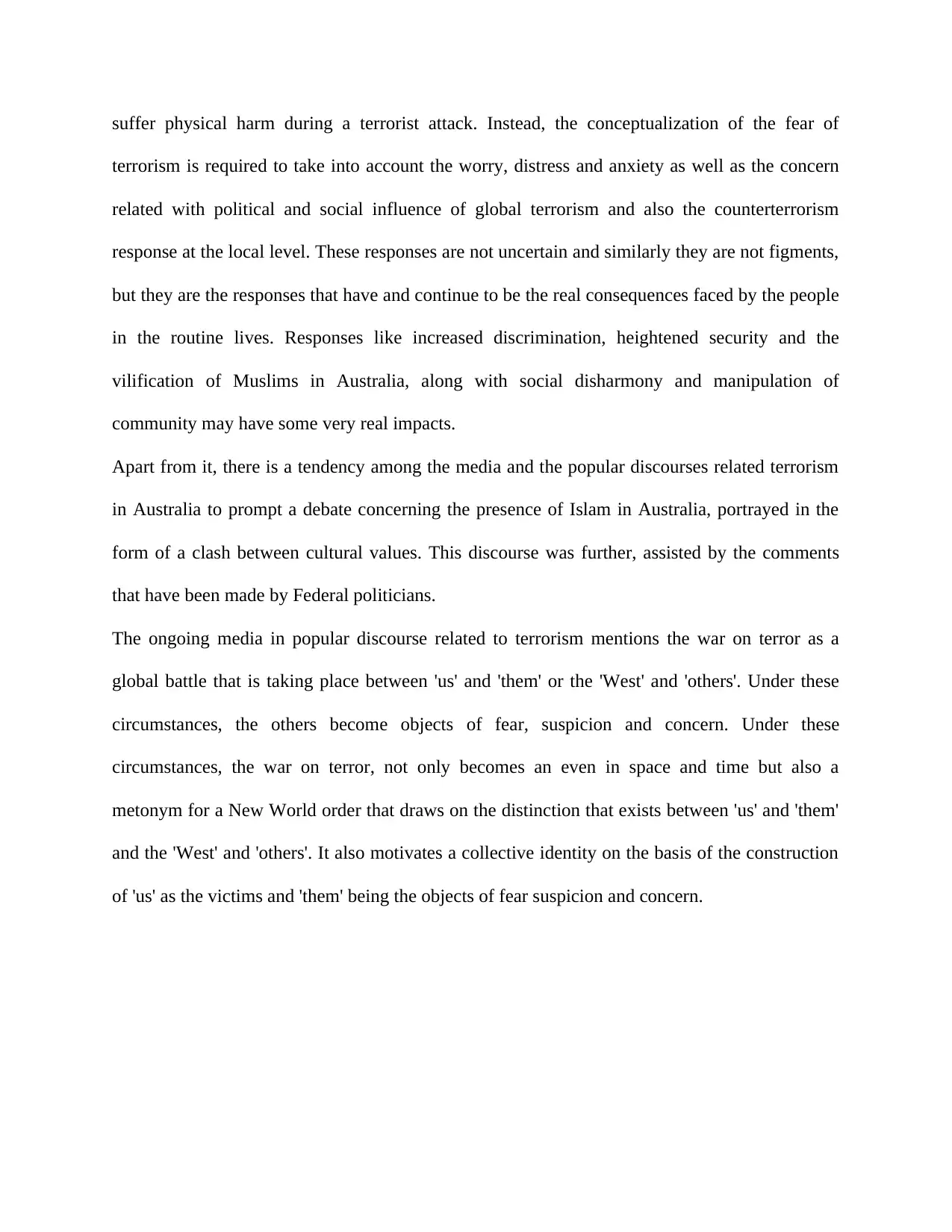
suffer physical harm during a terrorist attack. Instead, the conceptualization of the fear of
terrorism is required to take into account the worry, distress and anxiety as well as the concern
related with political and social influence of global terrorism and also the counterterrorism
response at the local level. These responses are not uncertain and similarly they are not figments,
but they are the responses that have and continue to be the real consequences faced by the people
in the routine lives. Responses like increased discrimination, heightened security and the
vilification of Muslims in Australia, along with social disharmony and manipulation of
community may have some very real impacts.
Apart from it, there is a tendency among the media and the popular discourses related terrorism
in Australia to prompt a debate concerning the presence of Islam in Australia, portrayed in the
form of a clash between cultural values. This discourse was further, assisted by the comments
that have been made by Federal politicians.
The ongoing media in popular discourse related to terrorism mentions the war on terror as a
global battle that is taking place between 'us' and 'them' or the 'West' and 'others'. Under these
circumstances, the others become objects of fear, suspicion and concern. Under these
circumstances, the war on terror, not only becomes an even in space and time but also a
metonym for a New World order that draws on the distinction that exists between 'us' and 'them'
and the 'West' and 'others'. It also motivates a collective identity on the basis of the construction
of 'us' as the victims and 'them' being the objects of fear suspicion and concern.
terrorism is required to take into account the worry, distress and anxiety as well as the concern
related with political and social influence of global terrorism and also the counterterrorism
response at the local level. These responses are not uncertain and similarly they are not figments,
but they are the responses that have and continue to be the real consequences faced by the people
in the routine lives. Responses like increased discrimination, heightened security and the
vilification of Muslims in Australia, along with social disharmony and manipulation of
community may have some very real impacts.
Apart from it, there is a tendency among the media and the popular discourses related terrorism
in Australia to prompt a debate concerning the presence of Islam in Australia, portrayed in the
form of a clash between cultural values. This discourse was further, assisted by the comments
that have been made by Federal politicians.
The ongoing media in popular discourse related to terrorism mentions the war on terror as a
global battle that is taking place between 'us' and 'them' or the 'West' and 'others'. Under these
circumstances, the others become objects of fear, suspicion and concern. Under these
circumstances, the war on terror, not only becomes an even in space and time but also a
metonym for a New World order that draws on the distinction that exists between 'us' and 'them'
and the 'West' and 'others'. It also motivates a collective identity on the basis of the construction
of 'us' as the victims and 'them' being the objects of fear suspicion and concern.
⊘ This is a preview!⊘
Do you want full access?
Subscribe today to unlock all pages.

Trusted by 1+ million students worldwide
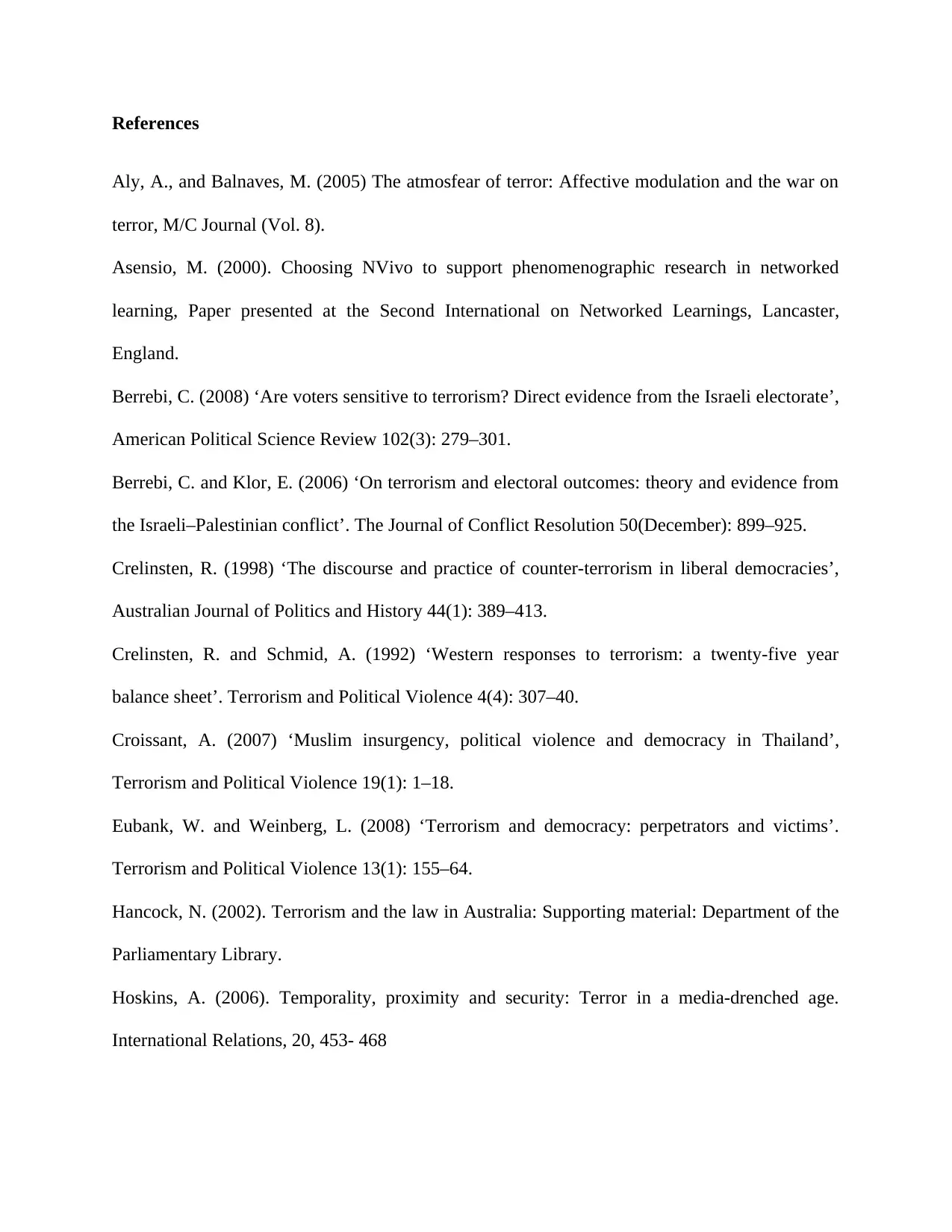
References
Aly, A., and Balnaves, M. (2005) The atmosfear of terror: Affective modulation and the war on
terror, M/C Journal (Vol. 8).
Asensio, M. (2000). Choosing NVivo to support phenomenographic research in networked
learning, Paper presented at the Second International on Networked Learnings, Lancaster,
England.
Berrebi, C. (2008) ‘Are voters sensitive to terrorism? Direct evidence from the Israeli electorate’,
American Political Science Review 102(3): 279–301.
Berrebi, C. and Klor, E. (2006) ‘On terrorism and electoral outcomes: theory and evidence from
the Israeli–Palestinian conflict’. The Journal of Conflict Resolution 50(December): 899–925.
Crelinsten, R. (1998) ‘The discourse and practice of counter-terrorism in liberal democracies’,
Australian Journal of Politics and History 44(1): 389–413.
Crelinsten, R. and Schmid, A. (1992) ‘Western responses to terrorism: a twenty-five year
balance sheet’. Terrorism and Political Violence 4(4): 307–40.
Croissant, A. (2007) ‘Muslim insurgency, political violence and democracy in Thailand’,
Terrorism and Political Violence 19(1): 1–18.
Eubank, W. and Weinberg, L. (2008) ‘Terrorism and democracy: perpetrators and victims’.
Terrorism and Political Violence 13(1): 155–64.
Hancock, N. (2002). Terrorism and the law in Australia: Supporting material: Department of the
Parliamentary Library.
Hoskins, A. (2006). Temporality, proximity and security: Terror in a media-drenched age.
International Relations, 20, 453- 468
Aly, A., and Balnaves, M. (2005) The atmosfear of terror: Affective modulation and the war on
terror, M/C Journal (Vol. 8).
Asensio, M. (2000). Choosing NVivo to support phenomenographic research in networked
learning, Paper presented at the Second International on Networked Learnings, Lancaster,
England.
Berrebi, C. (2008) ‘Are voters sensitive to terrorism? Direct evidence from the Israeli electorate’,
American Political Science Review 102(3): 279–301.
Berrebi, C. and Klor, E. (2006) ‘On terrorism and electoral outcomes: theory and evidence from
the Israeli–Palestinian conflict’. The Journal of Conflict Resolution 50(December): 899–925.
Crelinsten, R. (1998) ‘The discourse and practice of counter-terrorism in liberal democracies’,
Australian Journal of Politics and History 44(1): 389–413.
Crelinsten, R. and Schmid, A. (1992) ‘Western responses to terrorism: a twenty-five year
balance sheet’. Terrorism and Political Violence 4(4): 307–40.
Croissant, A. (2007) ‘Muslim insurgency, political violence and democracy in Thailand’,
Terrorism and Political Violence 19(1): 1–18.
Eubank, W. and Weinberg, L. (2008) ‘Terrorism and democracy: perpetrators and victims’.
Terrorism and Political Violence 13(1): 155–64.
Hancock, N. (2002). Terrorism and the law in Australia: Supporting material: Department of the
Parliamentary Library.
Hoskins, A. (2006). Temporality, proximity and security: Terror in a media-drenched age.
International Relations, 20, 453- 468
Paraphrase This Document
Need a fresh take? Get an instant paraphrase of this document with our AI Paraphraser
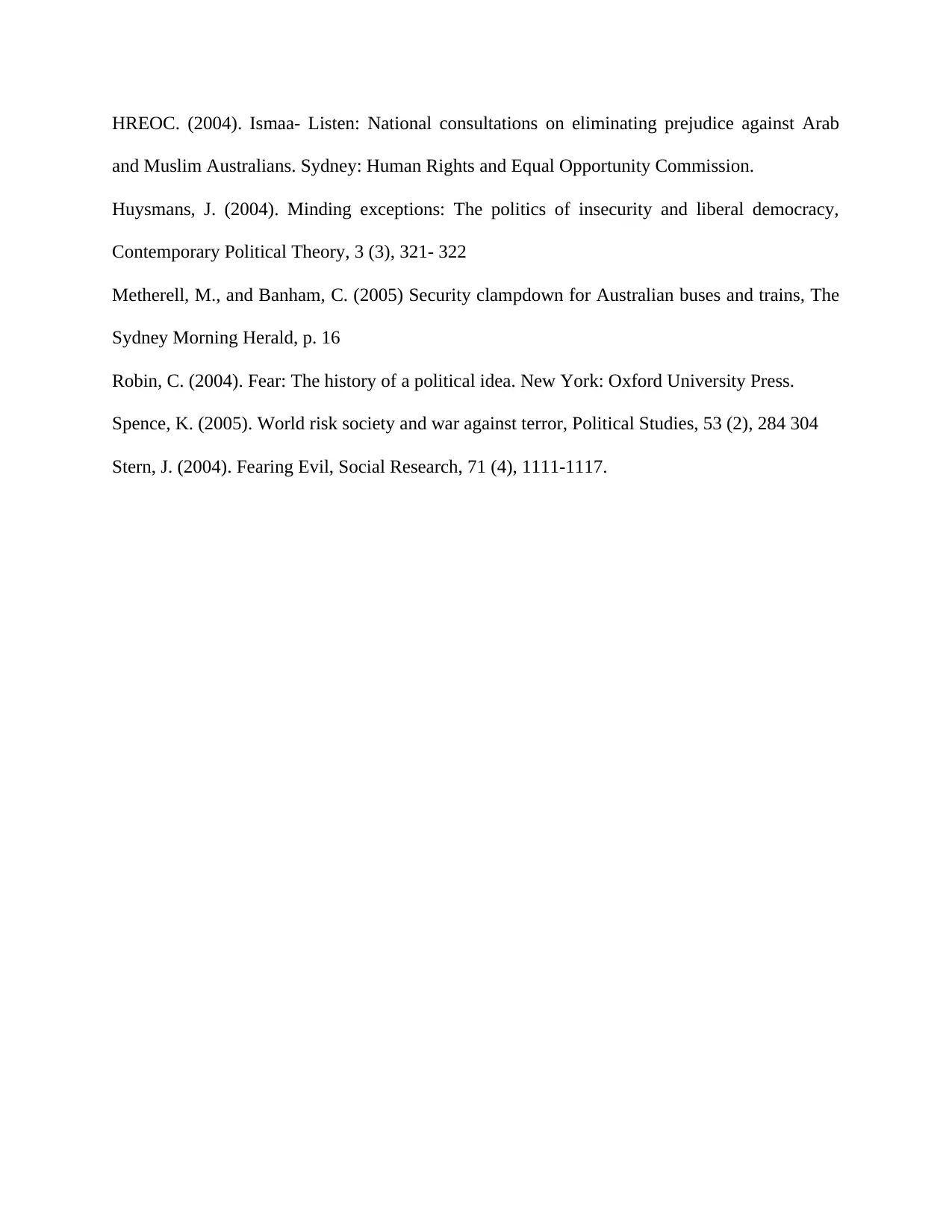
HREOC. (2004). Ismaa- Listen: National consultations on eliminating prejudice against Arab
and Muslim Australians. Sydney: Human Rights and Equal Opportunity Commission.
Huysmans, J. (2004). Minding exceptions: The politics of insecurity and liberal democracy,
Contemporary Political Theory, 3 (3), 321- 322
Metherell, M., and Banham, C. (2005) Security clampdown for Australian buses and trains, The
Sydney Morning Herald, p. 16
Robin, C. (2004). Fear: The history of a political idea. New York: Oxford University Press.
Spence, K. (2005). World risk society and war against terror, Political Studies, 53 (2), 284 304
Stern, J. (2004). Fearing Evil, Social Research, 71 (4), 1111-1117.
and Muslim Australians. Sydney: Human Rights and Equal Opportunity Commission.
Huysmans, J. (2004). Minding exceptions: The politics of insecurity and liberal democracy,
Contemporary Political Theory, 3 (3), 321- 322
Metherell, M., and Banham, C. (2005) Security clampdown for Australian buses and trains, The
Sydney Morning Herald, p. 16
Robin, C. (2004). Fear: The history of a political idea. New York: Oxford University Press.
Spence, K. (2005). World risk society and war against terror, Political Studies, 53 (2), 284 304
Stern, J. (2004). Fearing Evil, Social Research, 71 (4), 1111-1117.
1 out of 8
Related Documents
Your All-in-One AI-Powered Toolkit for Academic Success.
+13062052269
info@desklib.com
Available 24*7 on WhatsApp / Email
![[object Object]](/_next/static/media/star-bottom.7253800d.svg)
Unlock your academic potential
Copyright © 2020–2025 A2Z Services. All Rights Reserved. Developed and managed by ZUCOL.





